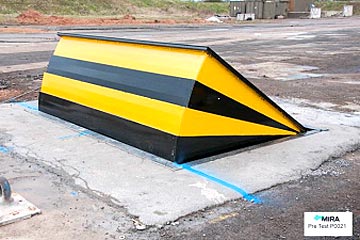Wedge Barriers Things To Know Before You Get This
Wiki Article
The smart Trick of Wedge Barriers That Nobody is Discussing
Table of ContentsThe Only Guide to Wedge BarriersThe Ultimate Guide To Wedge Barriers


The spring pole 58 is paired to a webcam(e. g., cam 80 received FIG. 4) of the lifting device 50. The springtimes 60 disposed regarding the spring pole 58 are held in compression by spring sustains 62, including a repaired spring assistance 64. That is, the set spring support 64 is fixed loved one to the structure 14 and the rest of the bather 10.
See This Report about Wedge Barriers
The staying force used to the cam camera deploy the wedge plate 16 may be provided by an electromechanical actuator 84 or other various other. The springtime setting up 54 and the actuator 84(e. Wedge Barriers. g., electromechanical actuator)may operate with each other to convert the cam and lift the wedge plate 16.
As discussed over, the spring setting up 54 exerts a constant force on the cam, while the electromechanical actuator might be regulated to apply a variable pressure on the cam, therefore making it possible for the training and lowering( i. e., releasing and withdrawing )of the wedge plate 16. In particular personifications, the constant force applied by the spring assembly 54 might be adjustable. g., electromechanical actuator) is handicapped. As will certainly be valued, the springtime setting up 54 may be covered and safeguarded from debris or other components by a cover plate(e. g., cover plate 68 received FIG. 4) that may be considerably flush with the raised surface 38 of the structure 14. As stated over, in the deployed setting, the wedge plate 16 serves to block accessibility or travel past the obstacle 10. The obstacle 10(e. g., the wedge plate 16 )might obstruct pedestrians or cars from accessing a property or pathway. As gone over over, the barrier 10 is connected to the anchor 30 safeguarded within the foundation 14,

front brackets 71. As a result, the linkage settings up 72 might pivot and turn to enable the collapse and expansion of the linkage assemblies 72 throughout see post retraction and release of the bather 10. The link assemblies 72 cause activity of the wedge plate 16 to be restricted. As an example, if a vehicle is taking a trip towards the released wedge plate 16(e. For instance, in one condition, the safety and security legs 86 may be extended throughoutupkeep of the barrier 10. When the security legs 86 are released, the security legs 86 support the weight of the wedge plate 16 versus the surface 12. Therefore, the training device 50 may be shut off, serviced, eliminated, replaced, etc. FIG. 5 is partial viewpoint view of a personification of the surface-mounted wedge-style obstacle 10, illustrating the web cam 80 and the cam surface areas 82 of the lifting system 50. Specifically, 2 webcam surfaces 82, which are described as lower cam surfaces 83, are positioned below the web cam 80. The lower cam surface areas 83 may be repaired to the surface area 12 (e. For example, the lower web cam surfaces navigate to these guys 83 and the placing plate 85 may develop a single piece that is secured to the anchor 30 by screws or various other mechanical bolts. Furthermore, 2 camera surface areas 82, which are described as upper cam surfaces 87, are placed above the webcam 80 and combined to (e. In other embodiments, interfering layers or plates might be positioned between the surface 12 and the lower cam surfaces 83 and/or the wedge plate 16 and the top web cam surfaces 87 As pointed out over, the web cam 80 equates along the web cam surfaces 82 when the wedge plate 16 is lifted from the withdrawed position to the released setting. Additionally, as mentioned over, the springtime assembly 54 (see FIG. 3 )may give a force acting upon the camera 80 in the instructions 102 via springtime pole 58, which might reduce the force the electromechanical actuator 84 is required to these details put on the camera 80 in order to actuate and lift the wedge plate 16. 1 )to the released placement(see FIG. 4). As shown, the cam 80 includes track wheels 104(e. g., rollers), which contact and equate along the camera surface areas 82 throughout operation.
Report this wiki page